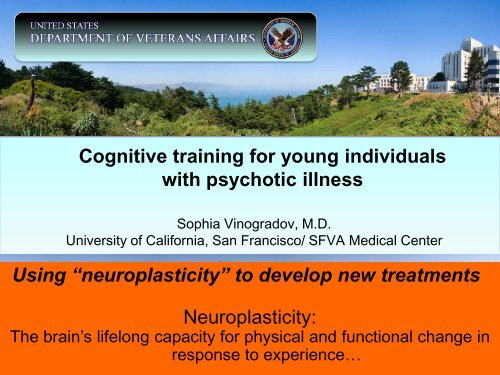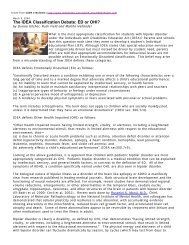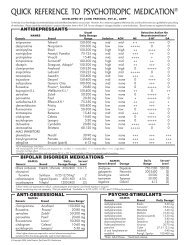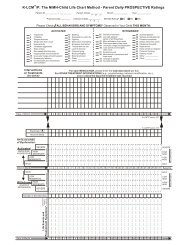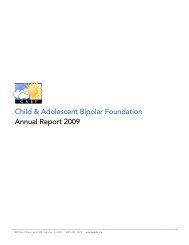Cognitive Training for Young Individuals with Psychotic Illnesses
Cognitive Training for Young Individuals with Psychotic Illnesses
Cognitive Training for Young Individuals with Psychotic Illnesses
You also want an ePaper? Increase the reach of your titles
YUMPU automatically turns print PDFs into web optimized ePapers that Google loves.
Presenter Disclosure• The following personal financial relationships <strong>with</strong>commercial interests relevant to this presentationexist:• The cognitive training software described in thispresentation was supplied free of charge by PositscienceInc.• Sophia Vinogradov is a paid consultant on an NIMHBRDG-SPAN grant to Brain Plasticity Inc., a company<strong>with</strong> a commercial interest in the cognitive trainingsoftware described in this presentation.
What do we know about early psychosis?• Multiple cognitive deficits are present, even be<strong>for</strong>e thefirst episode. (Becker 2010; Kravariti 2009; Leeson 2009: Mesholam-Gately2009)• Some of these deficits worsen during the transition topsychosis. (Jahshan 2010; Keefe 2006)• Some of these deficits predict functional outcome.(Leeson 2010; Milev 2005)• Patients show progressive brain changes andabnormal/inefficient brain activation patterns. (e.g., Crossley2009; Morey 2005; Sun 2009)
This suggests that…• <strong>Cognitive</strong> dysfunction represents significant risk <strong>for</strong>psychosis, and also indicates poor prognosis.• Early psychosis is the initial phase of a chronicneurocognitive disorder characterized by inefficientcortical processing.• <strong>Cognitive</strong> dysfunction and underlying neural networkinefficiency should be a primary target <strong>for</strong> intervention inearly psychosis.
In individuals <strong>with</strong> psychosis,the cortex has difficulty <strong>with</strong>:• The speed and fidelity of early neural responses toinputs.• The integration of neural responses <strong>with</strong>in and acrosscortical regions.• The maintenance of attentional control/salience.• The ability to associate, encode, and retrieve salientevents, thoughts, and actions.Neurons that are out of synch… fail to link…
For example, monkeys trainedto apply the tips of their 2 nd and3 rd fingers to a rotating disc……show substantially enlargedcortical representations of thosedigits’ tips.We know from basic science that:• The accuracy, fidelity, and efficiency of neural systemscan be improved through intensive, progressive,heavily rewarded, perceptual and cognitive training.(e.g., Jenkins 1990; Merzenich 1999)
Could this approach be used <strong>for</strong> humanneurocognitive disorders?Improve speed and accuracyof in<strong>for</strong>mation processingRe-refine brain maps and brainactivation patternsStrengthen neuromodulatoryfunctionHuman braintrainingexercises thatimprove thesefunctionscould have abeneficialeffect10
Why would this be helpful?Life FunctionWorkSocialLeisure<strong>Cognitive</strong> FunctionAttentionLanguageLearning and MemoryProblem SolvingNeural Systems FunctionSpeed of in<strong>for</strong>mation processingAccuracy of in<strong>for</strong>mation processingNeuromodulatory regulation11
San Francisco VA Medical Center
The “targeted cognitive training” consists of:• A heavy schedule of computerized training delivered asa stand-alone treatment.• Psychophysical training is embedded <strong>with</strong>in a suite ofincreasingly complex auditory and verbal workingmemory/verbal learning exercises.• Goal is to increase the accuracy, the temporally-detailedresolution, and the power of speech inputs feedingverbal memory processes– to induce widespread plasticchanges throughout the verbal encoding network.Neurons that fire together, wire together…
<strong>Cognitive</strong> improvement is seen after 10 weeksof targeted cognitive training (TCT) but notcomputer games control condition (CG)0.80TCT (N=40) CG (N=34) *p=.05, **p
Global cognition remains improved 6-months laterin TCT (N=27) but not CG (N=24) subjectsZ-Score0.0-0.2-0.4-0.6-0.8-1.0-1.2-1.4-1.6Baseline Post-BFP 6-MonthsTCT Global CognitionCG Global CognitionResults of Repeated Measures ANOVA: Relative to the CG group, the TCT group showsignificant gains in Global Cognition from Baseline to Post-<strong>Training</strong> (p < .01), and significantgains from baseline to 6-Months Post <strong>Training</strong> at trend level (p=.08).
Serum BDNF levels increase in response to targetedcognitive trainingRepeated measures ANOVA<strong>with</strong> post hoc contrasts:AT and CG subject groupsdiffered significantly in serumBDNF from Baseline to Week2 (p= .03) and from Baselineto post-training (p=.02).AT and Healthy Controlsubjects differed significantly inBaseline serum BDNF level.By Post-<strong>Training</strong>, serum BDNFlevel of AT subjects iscomparable to healthy controlsubjects.Serum BDNF (ng/ml)3432302826242220Baseline* (p=.03) Week 2 Week 12AT (N=30)Healthy Controls (N=16, Baseline only)Vinogradov, Fisher, Holland, Wolkowitz, Mellon, Biol Psych, 2009
CG GroupAlpha-band resting-state functional connectivityshows significant increases aftertargeted cognitive trainingPOST–PRETCT GroupPOST–PRE
Gamma band activity in prefrontal cortex is significantlyincreased after training11763BaPa QuietTask,Post-PreTCT, n=17p=0.0034
Targeted cognitive training improves per<strong>for</strong>manceon a complex reality monitoring task and“normalizes” brainactivation patternsExperimental Reality Monitoring Task:Source memory <strong>for</strong> self-generated in<strong>for</strong>mationSTUDY PHASE PRIOR TO SCANNINGThe rabbit ate the __________.The sailor sailed the sea.The dog chased the ________.The girl played <strong>with</strong> the ball.
During fMRI scan: Reality-monitoring retrieval trialsrabbit-carrotJittered Times:7-9sSelf-generated word = L pressExternally presented word = R press+sailor-sea1s7-9s1sHit window0.5-3.5sAdapted fromVinogradov et al, Cerebral Cortex. 2008
At baseline, SZ subjects show poor per<strong>for</strong>manceand no mPFC activationd prime score2.52.01.51.00.50.0Baseline Behavioral Per<strong>for</strong>manceSelf Correct*** * nsExternal Correct*** p < .0005* ns p =.09HCsSZsD-prime score <strong>for</strong> self-generateditemsmPFC activation across 15 HCs43210r = 0.58, p = .020 1 2 3MPFC signal <strong>for</strong> self-generateditem recallPCC activation across 31 SZt = 3.79, p
After training, SZ subjects show significantimprovement in recognizing self-generateditems…
…and now show mPFC activation during task per<strong>for</strong>mance(Post-intervention > Baseline)t = 7.93,p
MPFC activation after training predictsenhanced social functioning 6 monthslaterSocial functioning 6 months aftercomputerized training6543210r s = .61, p = .05-1-4 -2 0 2 4 6Mean mPFC signal <strong>for</strong> self-generatedminus externally-presented itemsafter 80 hours vs baseline
<strong>Cognitive</strong> improvement also occurs after 40 hours ofTCT but not CG in young recent-onset subjects, but<strong>with</strong> a slightly different pattern of results1.0TCT (N=20) CG (N=21) * < .050.80.6Z-Score Change0.40.20.0-0.2-0.4-0.6-0.8-1.0*GlobalCognitionSpeed ofProcessingWorkingMemory*VerbalLearning andMemoryVisual Learningand Memory*ProblemSolvingResults of Repeated Measures ANCOVA controlling <strong>for</strong> age, gender and IQ: Relativeto the CG group, the TCT group shows significant gains in Global Cognition, VerbalLearning and Memory and Problem Solving.
Adolescents who are clinically ultra high riskalso show improvement after training1.0TCT (N=8)CG (N=6)0.80.6Z-Score Change0.40.20.0-0.2-0.4-0.6-0.8GlobalCognitionSpeed ofProcessingWorkingMemoryVerbalLearning andMemoryVisualLearning andMemoryProblemSolvingResults of Repeated Measures ANCOVA controlling <strong>for</strong> education and hours oftraining.Group x Time Interactions: Global Cognition p = 0.15; Verbal Learning and Memory p
Conclusions• “Neuroplasticity-based” cognitive training inschizophrenia results in improved cognitive per<strong>for</strong>manceand more normal brain activation patterns.• <strong>Training</strong>-induced increases in brain activation patternspredict real-world functional improvement 6 months later.• Similar patterns of improvement are observed in youngrecent-onset participants and in ultra-high riskadolescents.
• Ongoing research questions:– Can this approach be used to target other neuralsystem impairments, such as motivational disorders,impulsivity, emotion regulation?– Can we personalize training to target the specificprofile of deficits of a given individual?– Will training prove to be “pre-emptive” in youngindividuals?
With many thanks to our participants, theirfamilies, NIMH, SMRI, and…Adult Schizophrenia StudiesEarly Psychosis StudiesMelissa Fisher, Ph.D.Karuna Subramaniam, Ph.D.Sri Nagarajan, Ph.D.Leighton Hinckley, Ph.D.Corby Dale, Ph.D.Coleman Garrett, B.S.Henry Mahncke, Ph.D.Michael Merzenich, Ph.D.Tracy Luks, Ph.D.Rogerio Panizzutti, Ph.D.Rachel Loewy, Ph.D.Barbara Krisna-Stewart, Ph.D.Demian Rose, M.D.Ashley Lee, B.A.Daniel Mathalon, Ph.D., M.D.Judith Ford, Ph.D.Cameron Carter, M.D.Dan Ragland, Ph.D.Tara Niendam, Ph.D.


